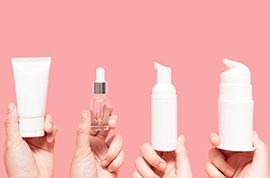All you need to know about Active and Non-active skincare ingredients

Navigating the world of skincare can be quite confusing at the beginning. Especially with all these names you cannot pronounce, all these products that you must have, and several techniques and skincare routines that you should have already been aware of. As we said, confusing and misleading.
Today, we are going to focus on the much-talked-about term “active and non-active” ingredients in skincare products and cosmetics.
It is always important to know what is in your products. Go beyond reading just the label. Check out the ingredients, their concentration, and do a little research about how it would interact with your skin type. People with sensitive skin should consult their dermatologist before trying new products. Doing a patch test on your forearm helps too.
What are active ingredients in skincare products?
Reading labels while shopping for skincare products can be a bit overwhelming. Especially when all the products use the same keywords like nourishing, rejuvenating, glowing, and the likes of it.
Certain products have their active ingredients listed on the package. The elements mentioned here are the ones that will deliver the benefits mentioned in the package. Active ingredients make a skincare product effective.
The Food and Drug Administration (FDA) has made it compulsory for brands to list out the active ingredients (Drugs) in the product's packaging.
The FDA also insists that the ingredients be mentioned in order of their concentration and prominence within the formula.
Some commonly listed active ingredients in skincare and cosmetics are AHAs, Vitamin C, Retinol, Salicylic Acid, Hyaluronic Acid, Vitamin E, Sulphur, and Niacinamide, among other things.
- A product is a cosmetic when it claims to alter your appearance. Cosmetics need not be pre-approved by FDA, but the ingredients must be safe for use.
- If the product has drugs in it and claims to treat or prevent a medical condition, then it MUST have all the active and non-active ingredients listed.
- A product that is meant for enhancing appearance but makes no medical claims need not list out the active and non-active ingredients.
Read the labels and packaging carefully before buying over-the-counter cosmetics and skincare products.
What are inactive ingredients in skincare products?
Listing out the inactive ingredients in the products is not an exercise in futility. The FDA has certain guidelines and rules that need to be followed when a product contains classified drugs and medically claims to enhance the appearance or provide treatments.
- Think of inactive ingredients as the vehicle, and the active ones as the passenger. The inactive ingredients will ensure that the active ingredients reach where they are needed.
- They also decide the form of the product that is cream, lotion, gel, serum, etc.
- Inactive ingredients make the products smell good, ensure that there’s no microbial growth and chemical decomposition and help improve the product performance in general.
- Some common inactive ingredients are in the form of emulsifiers, buffers, thickeners, fragrance, surfactant, preservatives, and emollients, among other things.
Now that you have a better idea of what active and inactive ingredients are, let us learn how these ingredients make the skin brighter, smoother, and softer.
Benefits of active and non-active ingredients in skincare
- AHAs are chemical exfoliators that help remove dead skin cells. You can find them in toners, cleansers, masks, and creams.
- Retinol helps to unclog pores, boost cell formation and give you smoother skin. It has the benefits of vitamin A derivatives and helps rejuvenate the skin at the cellular level.
- Hyaluronic acids help to keep your skin moisturized and hydrated in a way that gives your skin a dewy and supple look.
- Vitamin C helps keep our skin soft and youthful. It protects the skin from fine lines, sun damage, wrinkles, and free radicals.
- Salicylic acid is a BHA that works wonders on acne-prone skins. It helps prevent breakouts and reduces blackheads, too.
- Plant oils (like jojoba) make the perfect base for cleansers, moisturizers, and serums while plant butter is good for moisturization and skin protection (like shea butter).
- Aloe is a must-have in any skincare routine. Be it an extract, juice, or combined with other products. Its anti-inflammatory and soothing properties help prevent breakouts and give your skin the breather it needs.
- Natural clays like kaolin are good exfoliators. They leave the skin hydrated and moisturized too. Helps draw out impurities from the skin and stems bacterial growth if any.
Skincare is all about the formula. Finding the right balance goes a long way in helping skin repair and rejuvenation. It is imperative that you read and also understand the ingredients while making OTC purchases. Be a smart customer and look beyond labels and offers. Look for Dermatologist-formulated skincare, made for your skin type. Or consult a dermatologist for expert opinion. Try new things till you find all the perfect components for your daily skincare routine.
Make the purchase worth it.
لم يتم العثور على منتجات
تقيمنحن هنا دومًا للمساعدة
تواصل معنا من خلال أي من قنوات الدعم التالية:


رقم الهاتف: +97158 575 2023
الإيميل: [email protected]
العنوان: تقاطع شارع جميرا, دبي, الإمارات العربية المتحدة
© 2022 Wellbene, All Rights Reserved. Wellbene Life Sciences Fzco – Licence Number 12976

اخلاء مسؤولية: وجب التونيه، أن كل ما هو موجود من محتوى على هذا الموقع الإلكتروني ليس ببديل عن العناية، التشخيص،العلاج، أو الإرشادات والنصائح الطبية المتخصصة ولا يمكن استخدامه تحت أي ظرف لأي من هذه الأسباب. تأكد دومًا من استشارة طبيبك الخاص أو أي جهة مختصة ومعتمدة في حال كانت لديك ظروف صحية خاصة، أسئلة أو شكوك طبية. هذا الموقع يحتوي على آراء وتجارب الآخرين، ولا يعكس بأي حال من الأحوال رؤية شركة ويلبين أو أي من شركائها. الاعتماد على المعلومات المذكورة في هذا الموقع اختيارك الشخصي ومسؤوليته تقع على عاتقك.










